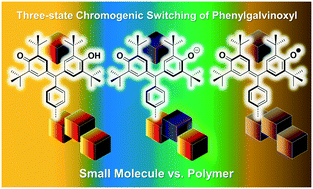Design of a three-state switchable chromogenic radical-based moiety and its translation to molecular logic systems†
Abstract
Three distinctly different and stable colored states of phenylgalvinoxyl (i.e., neutral phenolic, radical, and anionic species) small molecule and macromolecular systems are evaluated as a function of the solution pH. A clear halochromic effect is readily observed in the design of the polymer, in a manner that is distinct from the more oft-studied small molecule analogs. This key design paradigm allows the chemical nature of the phenylgalvinoxyl moieties to be comparable to a standard AND logic function, which evolves based upon the structural constitution of the material. Moreover, this crucial change in behavior allows for the revelation that the formation of the radical polymer that bears a galvinoxyl pendant group occurs through base-promoted step-wise oxidation, and this, in turn, provides a critical handle by which to design future radical polymer archetypes and to build molecular logic systems based upon this emerging class of functional materials.



 Please wait while we load your content...
Please wait while we load your content...